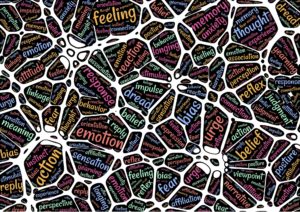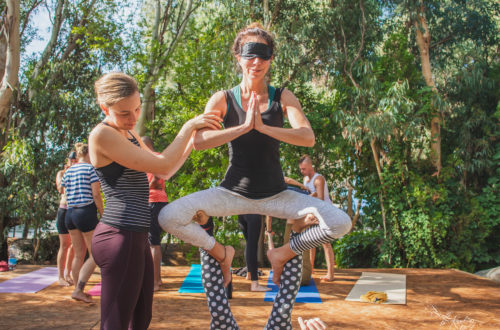
Feel it – don’t ignore it: Why Yogis may cry and scream and curse
“Yoga citta vritti nirodhah” – Yoga, mind, fluctuations, stillness.
Yoga is the cessation of the modifications, or fluctuations, of the mind. Just four little words Patanjali uses in the second verse of the Yogasutra to describe, what yoga actually means. And yet: four words so big to hold the whole universe of the human psyche in itself. What is this mind? How does it work? And how can it’s fluctuations calm down? All this is explained in the yoga philosophy. But what, if the mind just does not want to calm down? Why a yogi may cry, scream and curse …
I love the yoga philosophy: In theory, everything is so simple. Our mind is constantly in action, we think, feel, have needs, desires, we want things, or we reject things. Why we sometimes think like this and sometimes like that, why we sometimes desire this and another time that, lies in the depths of the mind. It is our memories and experiences, patterns and conditioning, insights or erroneous insights, that we have made, that drive the ever-wandering mind. The mind is constantly moving, or better: it is being moved. The everyday-consciousness is fully in the grip of the ego: We all strive for the things, that we consider to be good (for us). Some seek money, prestige, recognition, careers, others perhaps community, family, love. But no matter, what it is, we’re asking for: Ultimately, it is always the ego, that drives these desires, because the everyday-consciousness is inseparably linked to the ego. Whether we like it or not, whether we recognize it or not, what happens in us all day long, all thoughts and feelings are created by the ego. Mostly, we also identify with the ego and so mistakenly believe, that we think, act and feel self-determined.
The journey to yourself
This is where yoga comes in: Yoga can help us to become aware of these movements of the mind. Patanjali speaks of the attachment to the mental movement, that is supposed to be dissolved through yoga. And that’s really not rocket science. Everyone who meditates, knows this state. Maybe just a few seconds in the beginning, then a little longer, a few minutes, and maybe for the duration of a whole yoga practice: meditation in motion. For me, this moment feels like coming home. Everything else falls away and there is only this deep sense of security, this feeling, that there is so much more than the whole Ego-stuff. There are many floral, beautiful and cheesy descriptions for it. I just read one of these sayings on Facebook: Yoga is the journey of the self, through yourself, to yourself. In the yoga philosophy one speaks of svarupa, the essential identity, the true self. I like the notion of the true self because it makes clear, that in addition to what we commonly call our ego, namely the whole driven ego, there is something much deeper, that is untouched by all of this and constitutes our true nature. Kaivalya – in yoga the “freedom” – is there, when I can distinguish between the ego and the true self and when the attachment to the movements of the mind dissolves.
So far the theory. And what we can practice in yoga or experience in meditation ourselves. But at some point even the most beautiful yoga class, the most peaceful meditation will come to an end. And then everyday life breaks again. For a while we can still save a little bit of this feeling of resting in our true self. But the mind is like a wild horse, that has been restrained for so long, and now it’s trying to break out on all sides. Ego-driven thoughts and feelings can overrun you with such a power, that you can hardly resist it – even if you have already experienced the distinction of ego and true self in meditation. You just can not meditate all day.

Yoga is a powerful but also a slow way. It doesn’t mean anything, if you might have understood something by logic, as beautiful and logical the philosophy of yoga sounds. You can only experience it – and transfer the experience step by step, very slowly, over the years into everyday life. Then, perhaps at some point, this attachment to the movements of the mind, will decrease. But what am I doing now, in this concrete moment, when the feelings and thoughts are back with full force and the “Yogas citta vritti norodhah” seems miles away? What are you doing in such moments?
I believe, that one thing is very important: to dissolve the attachment to the thoughts and feelings does not mean, that you have no feelings or even thoughts anymore. Some people seem to confuse yoga or spirituality in general, to turn feelings off, or at least to pretend, that they do not have them. True to the motto: “Such low ego-driven feelings do not affect me!” A yogi does not cry, does not scream, may not explode with rage or let his sadness run wild? Such a nonsense! Every feeling has its justification, no matter, if the fear comes from old patterns, that one could have long ago let go, or the sadness only comes from the fact, that the ego was hurt. Only by accepting these feelings and by feeling in the heart exactly where they come from, I can become more independent of them. Everyone knows that: When you run away from fear, it gets bigger and bigger. The only way to build a relationship with yourself and others is to allow your feelings. This is the only way to “explore” them in the sense of yoga and gradually become more free.
Being authentic
The ego is not bad. While it usually determines our mind, it also makes us the individual we are in this life. The ego and the true self are not enemies, they go hand in hand. That is why it is not necessary to “overcome” the ego, as it is often called. On the contrary, if I’m really angry or sad, but smile away at all problems with a grin on my face, that does not get me closer to the goal. It builds boundaries: to myself and to my fellow human beings, because I am no longer authentic. Being authentic means accepting, what is happening right now.
There is a very nice meditation for it: direct your attention to your feelings, to what weighs on you. Whatever it is, pain, sadness, anger, fear: take it into your heart without judging or trying to overcome it. If you want to cry, cry, if you want to scream, scream. But always feel for your heart and try to see the truth behind your feelings. Often it is already this attention, that helps that they gradually transform.
The way to be aware of how the mind works, is not by ignoring the feelings. It leads through them. So one day we can have clearer thoughts and clearer feelings. They are always there, but we are not so torn by them anymore. For me this is the difference between equanimity and (pretended) indifference, the difference between authenticity and pretended spirituality.



